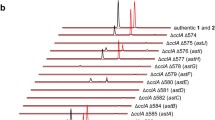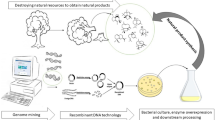Abstract
Fungal bifunctional terpene synthases (BFTSs) have been reported to contribute to the biosynthesis of a variety of di/sesterterpenes via different carbocation transportation pathways. Genome mining of new BFTSs from unique fungal resources will, theoretically, allow for the identification of new terpenes. In this study, we surveyed the distribution of BFTSs in our in-house collection of 430 pathogenetic fungi and preferred two BFTSs (CsSS and NnNS), long distance from previously characterized BFTSs and located in relatively independent branches, based on the established phylogenetic tree. The heterologous expression of the two BFTSs in Aspergillus oryzae and Saccharomyces cerevisiae led to the identification of two new sesterterpenes separately, 5/12/5 tricyclic type-A sesterterpene (schultriene, 1) for CsSS and 5/11 bicyclic type-B sesterterpene (nigtetraene, 2) for NnNS. In addition, to the best of our knowledge, 2 is the first 5/11 bicyclic type-B characterized sesterterpene to date. On the basis of this, the plausible cyclization mechanisms of 1 and 2 were proposed based on density functional theory calculations. These new enzymes and their corresponding terpenes suggest that the chemical spaces produced by BFTSs remain large and also provide important evidences for further protein engineering for new terpenes and for understanding of cyclization mechanism catalyzed by BFTSs.
Key points
• Genome mining of two BFTSs yields two new sesterterpenoids correspondingly.
• Identification of the first 5/11 ring system type-B product.
• Parse out the rational cyclization mechanism of isolated sesterterpenoids.






Similar content being viewed by others
Data availability
All data generated or analyzed during this study are included in the published article and electrical supplementary material available at https://doi.org/XXXX.
References
Baird RD, Tan DSP, Kaye SB (2010) Weekly paclitaxel in the treatment of recurrent ovarian cancer. Nat Rev Clin Oncol 7(10):575–582. https://doi.org/10.1038/nrclinonc.2010.120
Bian G, Rinkel J, Wang Z, Lauterbach L, Hou A, Yuan Y, Deng Z, Liu T, Dickschat JS (2018) A clade II-D fungal chimeric diterpene synthase from Colletotrichum gloeosporioides produces dolasta-1(15),8-diene. Angew Chem Int Ed 57(48):15887–15890. https://doi.org/10.1002/anie.201809954
Brakhage AA (2013) Regulation of fungal secondary metabolism. Nat Rev Microbiol 11(1):21–32. https://doi.org/10.1038/nrmicro2916
Bridgford JL, Xie SC, Cobbold SA, Pasaje CFA, Herrmann S, Yang T, Gillett DL, Dick LR, Ralph SA, Dogovski C, Spillman NJ, Tilley L (2018) Artemisinin kills malaria parasites by damaging proteins and inhibiting the proteasome. Nat Commun 9(1):3801. https://doi.org/10.1038/s41467-018-06221-1
Chen R, Jia Q, Mu X, Hu B, Sun X, Deng Z, Chen F, Bian G, Liu T (2021) Systematic mining of fungal chimeric terpene synthases using an efficient precursor-providing yeast chassis. Proc Natl Acad Sci 118(29):e2023247118. https://doi.org/10.1073/pnas.2023247118
Chen Y, Zhao J, Li S, Xu J (2019) Total synthesis of sesterterpenoids. Nat Prod Rep 36(2):263–288. https://doi.org/10.1039/c8np00050f
Christianson DW (2017) Structural and chemical biology of terpenoid cyclases. Chem Rev 117(17):11570–11648. https://doi.org/10.1021/acs.chemrev.7b00287
Christianson DW (2006) Structural biology and chemistry of the terpenoid cyclases. Chem Rev 106(8):3412–3442. https://doi.org/10.1021/cr050286w
Elissawy AM, El-Shazly M, Ebada SS, Singab AB, Proksch P (2015) Bioactive terpenes from marine-derived fungi. Mar Drugs 13(4):1966–1992. https://doi.org/10.3390/md13041966
Feng J, Maruyama J-I, Juvvadi PR, Arioka M, Kitamoto K (2004) Development of a novel quadruple auxotrophic host transformation system by argB gene disruption using adeA gene and exploiting adenine auxotrophy in Aspergillus oryzae. FEMS Mic Lett 239(1):79–85. https://doi.org/10.1016/j.femsle.2004.08.025
Ferreira RJ, Kincses A, Gajdács M, Spengler G, dos Santos DJVA, Molnár J, Ferreira M-JU (2018) Terpenoids from Euphorbia pedroi as multidrug-resistance reversers. J Nat Prod 81(9):2032–2040. https://doi.org/10.1021/acs.jnatprod.8b00326
Frisch MJ, Trucks GW, Schlegel J, Scuseria GE, Robb MA, Cheeseman JR, Schlegel HB, Scalmani G, Barone V, Mennucci B (2010) Gaussian 09, Revision C.01. Gaussian, Inc., Wallingford, CT. https://gaussian.com/g09citation/
Guo J, Cai YS, Cheng F, Yang C, Zhang W, Yu W, Yan J, Deng Z, Hong K (2021) Genome mining reveals a multiproduct sesterterpenoid biosynthetic gene cluster in Aspergillus ustus. Org Lett 23(5):1525–1529. https://doi.org/10.1021/acs.orglett.0c03996
Han J, Zhang J, Song Z, Zhu G, Liu M, Dai H, Hsiang T, Liu X, Zhang L, Quinn RJ, Feng Y (2020) Genome-based mining of new antimicrobial meroterpenoids from the phytopathogenic fungus Bipolaris sorokiniana strain 11134. Appl Microbiol Biotechnol 104(9):3835–3846. https://doi.org/10.1007/s00253-020-10522-1
Hong YJ, Tantillo DJ (2013) C-H⋯π interactions as modulators of carbocation structure – implications for terpene biosynthesis. Chem Sci 4(6):2512–2518. https://doi.org/10.1039/C3SC50571E
Jia Q, Chen X, Köllner TG, Rinkel J, Fu J, Labbé J, Xiong W, Dickschat JS, Gershenzon J, Chen F (2019) Terpene synthase genes originated from bacteria through horizontal gene transfer contribute to terpenoid diversity in fungi. Sci Rep 9(1):9223. https://doi.org/10.1038/s41598-019-45532-1
Jiang L, Zhang X, Sato Y, Zhu G, Minami A, Zhang W, Ozaki T, Zhu B, Wang Z, Wang X, Lv K, Zhang J, Wang Y, Gao S, Liu C, Hsiang T, Zhang L, Oikawa H, Liu X (2021a) Genome-based discovery of enantiomeric pentacyclic sesterterpenes catalyzed by fungal bifunctional terpene synthases. Org Lett 23(12):4645–4650. https://doi.org/10.1021/acs.orglett.1c01361
Jiang L, Zhu G, Han J, Hou C, Zhang X, Wang Z, Yuan W, Lv K, Cong Z, Wang X, Chen X, Karthik L, Yang H, Wang X, Tan G, Liu G, Zhao L, Xia X, Liu X, Gao S, Ma L, Liu M, Ren B, Dai H, Quinn RJ, Hsiang T, Zhang J, Zhang L, Liu X (2021b) Genome-guided investigation of anti-inflammatory sesterterpenoids with 5–15 trans-fused ring system from phytopathogenic fungi. Appl Microbiol Biotechnol 105(13):5407–5417. https://doi.org/10.1007/s00253-021-11192-3
Kim J, Baidoo EEK, Amer B, Mukhopadhyay A, Adams PD, Simmons BA, Lee TS (2021) Engineering Saccharomyces cerevisiae for isoprenol production. Metab Eng 64:154–166. https://doi.org/10.1016/j.ymben.2021.02.002
Knauseder F, Brandl E (1976) Pleuromutilins fermentation, structure and biosynthesis. J Antibiot 29(2):125–131. https://doi.org/10.7164/antibiotics.29.125
Li K, Gustafson KR (2020) Sesterterpenoids: chemistry, biology, and biosynthesis. Nat Prod Rep 38(7):1251–1281. https://doi.org/10.1039/d0np00070a
Minami A, Ozaki T, Liu C, Oikawa H (2018) Cyclopentane-forming di/sesterterpene synthases: widely distributed enzymes in bacteria, fungi, and plants. Nat Prod Rep 35(12):1330–1346. https://doi.org/10.1039/c8np00026c
Mitsuhashi T, Rinkel J, Okada M, Abe I, Dickschat JS (2017) Mechanistic characterization of two chimeric sesterterpene synthases from Penicillium. Chem Eur J 23(42):10053–10057. https://doi.org/10.1002/chem.201702766
Mitsuhashi T, Abe I (2018) Chimeric terpene synthases possessing both terpene cyclization and prenyltransfer activities. ChemBioChem 19(11):1106–1114. https://doi.org/10.1002/cbic.201800120
Narita K, Sato H, Minami A, Kudo K, Gao L, Liu C, Ozaki T, Kodama M, Lei X, Taniguchi T (2017) Focused genome mining of structurally related sesterterpenes: enzymatic formation of enantiomeric and diastereomeric products. Org Lett 19(24):6696–6699. https://doi.org/10.1021/acs.orglett.7b03418
Narita K, Minami A, Ozaki T, Liu C, Kodama M, Oikawa H (2018) Total biosynthesis of antiangiogenic agent (-)-terpestacin by artificial reconstitution of the biosynthetic machinery in Aspergillus oryzae. J Org Chem 83(13):7042–7048. https://doi.org/10.1021/acs.joc.7b03220
Oikawa H (2020) Reconstitution of biosynthetic machinery of fungal natural products in heterologous hosts. Biosci Biotechnol Biochem 84(3):433–444. https://doi.org/10.1080/09168451.2019.1690976
Quan Z, Dickschat JS (2020) Biosynthetic gene cluster for asperterpenols A and B and the cyclization mechanism of asperterpenol A synthase. Org Lett 22(19):7552–7555. https://doi.org/10.1021/acs.orglett.0c02748
Sato H, Narita K, Minami A, Yamazaki M, Wang C, Suemune H, Nagano S, Tomita T, Oikawa H, Uchiyama M (2018) Theoretical study of sesterfisherol biosynthesis: computational prediction of key amino acid residue in terpene synthase. Sci Rep 8(1):2473–2481. https://doi.org/10.1038/s41598-018-20916-x
Sharma KK (2016) Fungal genome sequencing: basic biology to biotechnology. Crit Rev Biotechnol 36(4):743–759. https://doi.org/10.3109/07388551.2015.1015959
Singh S, Dash AK (2009) Paclitaxel in cancer treatment: perspectives and prospects of its delivery challenges. Crit Rev Ther Drug Carrier Syst 26(4):333–372. https://doi.org/10.1615/critrevtherdrugcarriersyst.v26.i4.10
Tagami K, Minami A, Fujii R, Liu C, Tanaka M, Gomi K, Dairi T, Oikawa H (2014) Rapid reconstitution of biosynthetic machinery for fungal metabolites in Aspergillus oryzae: total biosynthesis of aflatrem. ChemBioChem 15(14):2076–2080. https://doi.org/10.1002/cbic.201402195
Tippelt A, Nett M (2021) Saccharomyces cerevisiae as host for the recombinant production of polyketides and nonribosomal peptides. Microb Cell Factories 20(1):161. https://doi.org/10.1186/s12934-021-01650-y
Toyomasu T, Tsukahara M, Kaneko A, Niida R, Mitsuhashi W, Dairi T, Kato N, Sassa T (2007) Fusicoccins are biosynthesized by an unusual chimera diterpene synthase in fungi. Proc Natl Acad Sci 104(9):3084–3088. https://doi.org/10.1073/pnas.0608426104
Tu Y (2016) Artemisinin-A gift from traditional Chinese medicine to the world (Nobel lecture). Angew Chem Int Ed 55(35):10210–10226. https://doi.org/10.1002/anie.201601967
Wang G, Kell DB, Borodina I (2021) Harnessing the yeast Saccharomyces cerevisiae for the production of fungal secondary metabolites. Essays Biochem 65(2):277–291. https://doi.org/10.1042/ebc20200137
Wang P, Gao X, Tang Y (2012) Complexity generation during natural product biosynthesis using redox enzymes. Curr Opin Chem Biol 16(3–4):362–369. https://doi.org/10.1016/j.cbpa.2012.04.008
Xu W, Cai X, Jung ME, Tang Y (2010) Analysis of intact and dissected fungal polyketide synthase-nonribosomal peptide synthetase in vitro and in Saccharomyces cerevisiae. J Am Chem Soc 132(39):13604–13607. https://doi.org/10.1021/ja107084d
Acknowledgements
We sincerely acknowledge Prof. Jun-lchi Maruyama in the University of Tokyo for the kind provision of A. oryzae NSAR1, Prof. Katsuya Gomi in the Tohoku University who provided vectors pUARA2 and pUSA2, and Prof. Yi Tang in the University of California who provided S. cerevisiae strains and vector pXW55. We sincerely thank Prof. Hideaki Oikawa in the Hokkaido University for valuable suggestions. Genome sequencing and assembly of strains Cytospora schulzeri CS12565 and Nectria nigrescens NN12199 were supported by funding from the Natural Science and Engineering Research Council of Canada to Prof. T. Hsiang.
Funding
The study was financially supported by the National Key Research and Development Program of China (2020YFA0907800 and 2019YFA0906200), the National Natural Science Foundation of China (21907031, 81903529, 21977029, 31720103901, 21877124), and the Open Project Funding of the State Key Laboratory of Bioreactor Engineering, the 111 Project (B18022).
Author information
Authors and Affiliations
Contributions
XL and LZ designed this project. XL and LJ arranged the research consortium, and TH sequenced and assembled genomic data. YW gave guidance to chemical calculation. CL provided strain material. HY, ZX, XL, and GZ carried out fermentation, compound purification, and structural elucidation. KL conducted the bioinformatic analyses and analyzed the data. WZ contributed to chemical calculation analysis. LJ and XL wrote the manuscript, and TH revised it. All authors discussed the results and approved the manuscript.
Corresponding author
Ethics declarations
Ethics approval
This article does not contain any studies with human participants or animals performed by any of the authors.
Conflict of interest
The authors declare no competing interests.
Additional information
Publisher's note
Springer Nature remains neutral with regard to jurisdictional claims in published maps and institutional affiliations.
Supplementary Information
Below is the link to the electronic supplementary material.
Rights and permissions
Springer Nature or its licensor holds exclusive rights to this article under a publishing agreement with the author(s) or other rightsholder(s); author self-archiving of the accepted manuscript version of this article is solely governed by the terms of such publishing agreement and applicable law.
About this article
Cite this article
Jiang, L., Yang, H., Zhang, X. et al. Schultriene and nigtetraene: two sesterterpenes characterized from pathogenetic fungi via genome mining approach. Appl Microbiol Biotechnol 106, 6047–6057 (2022). https://doi.org/10.1007/s00253-022-12125-4
Received:
Revised:
Accepted:
Published:
Issue Date:
DOI: https://doi.org/10.1007/s00253-022-12125-4




